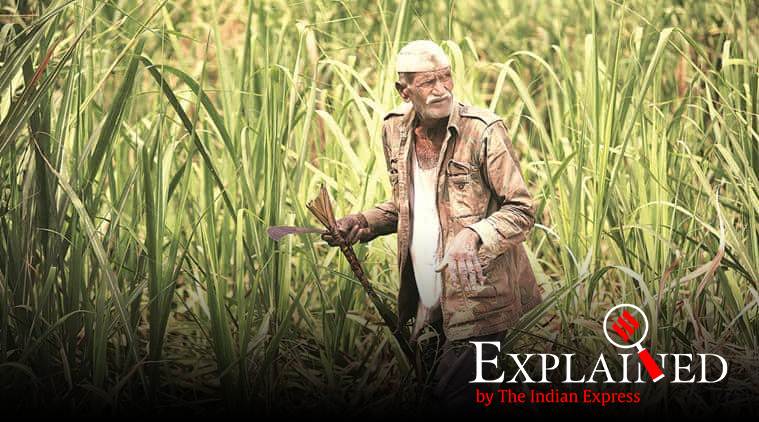
Starting this season, officers of the Sugar Commissionerate will publish Harvesting and Transportation (HnT) charges of individual mills in an area. How it will impact the millers and why are they apprehensive?
Maharashtra Sugar Commissioner Shekhar Gaikwad has introduced two crucial changes during the crushing season of 2019-20, and both of them are expected to change the way the industry functions. While millers have expressed strong reservations about the changes, some of them feel the move will help streamline the payment system for farmers.
The Indian Express looks at the changes and the impact they are likely to have.
The changes
* Farmers can transport their own cane
* Mills have to make harvesting and transportation costs public
Starting this season, officers of the Sugar Commissionerate will publish Harvesting and Transportation (HnT) charges of individual mills in an area. The list will have the Fair and Remunerative Price (FRP) net after deducting the HnT of individual mills, which is the real cane payment received by farmers after selling their produce to those mills. Farmers will also be allowed to harvest and transport their own cane. Seemingly simple, these changes have serious implications for both cane growers and millers.
Unlike their counterparts in Uttar Pradesh, mills in Maharashtra arrange for harvesting and transportation of cane from the farmers’ fields till the mill gate. Based on the date of planting of cane, mills draw up their harvesting calender to ensure the availability of cane across the season to maximise their operations. Once the season starts, the harvesting staff adheres to the calendar and transports harvested cane to the mills.
In lieu of this service, mills deduct the HnT charges from the final cane payment to the farmers. On an average the charges in Maharashtra are around Rs 550-600 per tonne of harvested cane. The state’s average recovery (ratio of sugar produced to cane crushed expressed as a percentage) is 11.24, and the FRP (for the current season, Rs 2,750 at base recovery of 10 per cent) works out to Rs 3,100 per tonne. So, average realisation for farmers who sell their cane to mills, with an average recovery of 11.24 per cent, works out to be Rs 2,550 per tonne.
Disadvantages of the new system
The current system seems to be working out in favour of both millers and farmers. The farmer doesn’t have to bother about transporting the cane while the mills are ensured quality harvested material for their operations. The harvesting is done by migrant workers who travel to the mills at the beginning of the season and leave once it is over. In case the harvested cane is mixed with other non-sucrose items such as leaves, mills report a dip in the sugar recovery. One of the main reasons why Maharashtra’s sugar recovery is higher than that of Uttar Pradesh is because the mills arrange for harvesting and transportation of cane.
Advantages of the new system
A closer look at the current system, however, highlights some deficiencies. The decision of the mill to levy average HnT charges may be advantageous to some farmers, but it works out against other farmers. On an average, mills procure cane from within a radius of 50-60 km around them. For farmers whose fields are further away from the mills, the transportation of cane is an advantage, but not so much for farms closer to the mills, which can transport the cane and save the HnT charges.
But HnT charges for mills in Solapur, Ahmednagar, Nashik and Marathwada, which account for around 40 per cent of the state’s total sugar production, have started charging HnT in the range of Rs 800-900 per tonne, which is a substantial amount of the total earnings of the farmers. These mills, meanwhile, cite the extra distance they have to cover to procure enough cane to justify higher HnT charges.
But farmer leaders and organisations have alleged that the millers are inflating the HnT charges and going out of their way to favour relatives, friends and supporters of the mill directors, whose fields are located further away. The issue had led to multiple complaints in earlier crushing seasons, and the then sugar commissioner had asked the Maharashtra State Cooperative Sugar Factories Federation to decide on a formula to address this problem.
The Federation had asked district collectors to submit details of transportation charges in slabs of 25 km (0-25/ 25-50 etc) to help them formulate the charges. But the exercise was not very successful as collectors had failed to provide the necessary details. The sugar commissioner finally decided to announce distance-based HnT charges, which was challenged by the Federation.
What has the Sugar Commissioner done and why are mills apprehensive?
The commissioner has decided to make the HnT charges of mills public and also allow farmers to harvest and transport their own cane. The commissioner is hopeful that making the HnT charges public will help farmers choose which mill to sell their cane to, and where their realisation will be maximum as mills will not deduct the HnT charges in such cases.
This move may also help build up pressure on mills to streamline their HnT charges and avoid procuring cane from financially unaviable distances.
But millers have said the process will have operational hurdles and expressed doubts about the farmers’ ability to arrange for harvesters and transportation of cane. They fear that this will eventually affect the sugar recovery of mills. Millers have also pointed out that the current system has been in place for a long time and cautioned that any bid to change it may backfire.


No comments:
Post a Comment